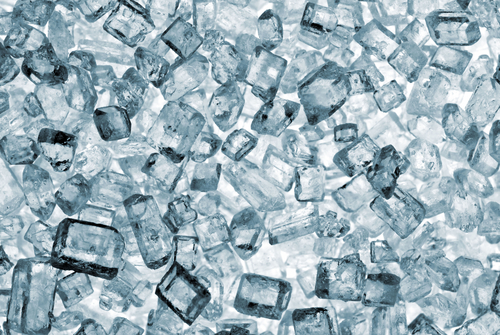 Crystals are beautiful objects in their own right, especially when they’re big enough to dazzle the eye. They’re also hugely important in our daily lives, with everyday examples including table salt and sugar.
Crystals are beautiful objects in their own right, especially when they’re big enough to dazzle the eye. They’re also hugely important in our daily lives, with everyday examples including table salt and sugar.
What all crystals have in common is that they consist of repeating units, a bit like ornamental brick paving but in three dimensions rather than two. The repeated units vary from one crystal to the next, and are arranged in symmetrical arrays.
Single crystal x-ray crystallography uses x-rays to discover the symmetrical structure of a crystal and the nature of the individual repeating units. When an x-ray beam ‘hits’ a crystal, the x-rays are deflected by the atoms in the crystal and can be captured on high-tech detectors. The patterns created by the deflected x-ray beams tell us about the positioning of the atoms in the crystal. Researchers use sophisticated computer software to solve the structures of their crystals. Single crystal x-ray crystallography is a powerful technique that has led to many advances in science, for example in medicine and biology, by solving the structures of proteins that are important in particular diseases and showing us how we can develop drugs to stop or modify the action of these proteins.
Scientists can get very excited about crystals that are much smaller than the width of a human hair because some proteins and other molecules are very difficult to persuade to form large single crystals.
The Australian Synchrotron has two main single crystal x-ray diffraction beamlines called MX1 and MX2 that are used by scientists from around Australia, New Zealand and the rest of the world.
The Synchrotron’s parent company ANSTO is one of many science agencies around the world organising events to celebrate the International Year of Crystallography. 2014 marks a century since we discovered that x-rays could be used to 'see' the structure of matter in a non-intrusive manner, thanks to the work of researchers such as William Henry Bragg and his Australian-born son William Lawrence Bragg.
On 26 February 2014, ANSTO launched a new micro-website to celebrate crystallography – a vibrant website to help those of us less familiar with the technique realise the enormous impact it’s had on modern civilisation. The site offers stories, videos and other resources.
Public events organised by ANSTO in 2014 will likely include interactive gameshow-style presentations and sculpture installations in the Melbourne CBD.
